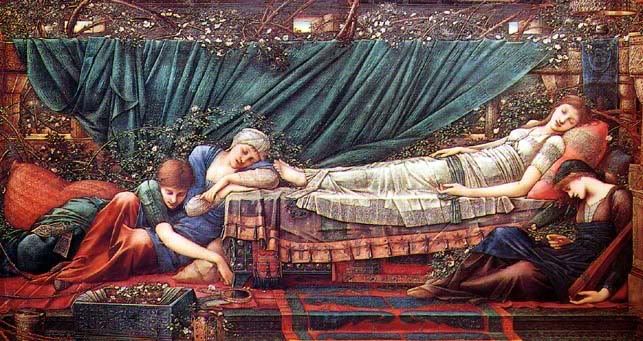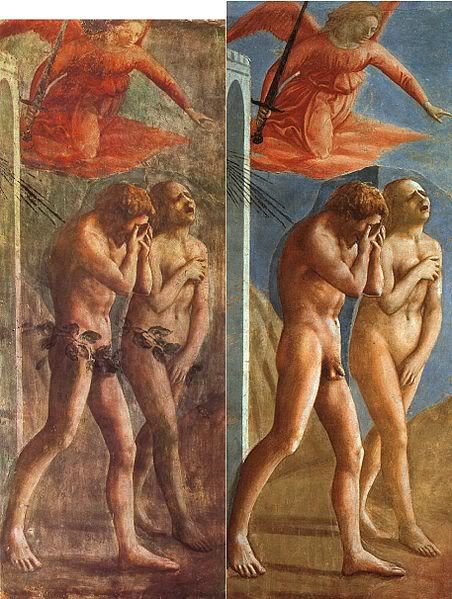Welcome to the February 1, 2012 edition of art history carnival! Thank you everyone for your submissions. I had a wonderful time reading them all. This month's carnival covers a number of different subject areas, and it's so nice to see that bloggers are writing about such a wide variety of topics, from video games to censorship and the Twilight series.
Everyone knows that art history mysteries are exciting, especially when an undiscovered masterpiece might be involved. It's all very intriguing, but there is a lot of work involved in establishing the provenance of an artwork, as our first article shows. H Niyazi of Three Pipe Problem presents The circular fortunes of the von Baden Madonna saying, "Little known outside specialist circles, a panel painting depicting a Madonna and Child in a Landscape has been forwarded as a possible early work by none other than Raphael. In an exclusive presentation, 3PP examines the stylistic and technical evidence related to this piece, including an intriguing smaller version of it." This piece is a must-read for anyone who enjoys following art auctions, and the painting itself is truly lovely. It sold for $290k USD at auction, which I venture to say was a bargain, no matter who painted it.
Christian Opitz of L'Historien Errant presents Giotto's Frescos in Naples (Lost Artworks #1), noting that "Giotto or non-Giotto, today the bare white walls of both Santa Chiara and the Cappella Magna are striking reminders of just how much great 14th century art has been lost in Naples alone."
Fortunately, science and history have been able to help us to reconstruct artworks so that we can better understand how they might have appeared in the past. Christina Daniel, whose blog Daydream Tourist focuses on art and travel, discusses the digital reconstruction of the Duccio's Maesta, concluding that "The Maestà demonstrates that reconstruction, at least digitally, goes a long way in understanding the artist’s intentions, the work’s visual impact, and how contemporary viewers would have encountered the piece."
What might Leonardo's interest in storms have to do with the art in video games? "Like Leonardo’s study of fluid dynamics, programmers needed to understand particle physics (as well as fluid dynamics) in order to create game engines capable of natural weather effects." Glennis McGregor explores Leonardo's legacy in the gaming world in Natural Systems: Leonardo's Energy Charge posted at her delightful blog, Renaissance for Real.
Ever notice that women spend an awful lot of time sleeping in books...and in art? Heidenkind aka Tasha B. explores the "narcoleptic heroine phenomenon" in her post The Girl Who Slept posted at Truth, Beauty, Freedom, and Books.
Another common theme in art(particularly in Victorian art, although I've probably noticed it more there because that's the subject area I'm most familiar with)is the rather questionable portrayal of young girls. Kirsty Stonell Walker, author of "Stunner: the fall and rise of Fanny Cornforth" and The Kissed Mouth has done an excellent two post series on the subject that begins with a nuanced examination of Victorian childhood (and girlhood in particular) in a post entitled "Thank Heavens for Little Girls." It's definitely worth a read!
While images of sleeping women never seem to raise too many alarm bells, and the odd inappropriate gaze towards young children is often ignored, the humble nude has caused quite a bit of controversy throughout art history. I still remember when my University ordered a cherub fountain for the garden next to our library. It had the most ridiculous little ribbon awkwardly draped around its nether regions. The effect was patently ridiculous. I always wondered how the artist must have felt! (and if the University was so offended by nude art, why did they choose a cherub in the first place?). And censorship often backfires, raising more eyebrows and drawing more attention to the matter than it would if artists were left to themselves.
Monica Bowen's piece The Prude Nude: Censorship and Cover-Ups in Art posted at Alberti's Window highlights the irony of censorship, noting that "In many respects, one can argue that these “cover-ups” ended up having a reverse effect than what was intended. Even the outcries against nudity just cause people to focus on the naked figures even more."
That concludes this edition. Submit your blog article to the next edition of
art history carnival
using our
carnival submission form.
Past posts and future hosts can be found on our
blog carnival index page.
Technorati tags:
art history carnival, blog carnival.
art mysteries
Everyone knows that art history mysteries are exciting, especially when an undiscovered masterpiece might be involved. It's all very intriguing, but there is a lot of work involved in establishing the provenance of an artwork, as our first article shows. H Niyazi of Three Pipe Problem presents The circular fortunes of the von Baden Madonna saying, "Little known outside specialist circles, a panel painting depicting a Madonna and Child in a Landscape has been forwarded as a possible early work by none other than Raphael. In an exclusive presentation, 3PP examines the stylistic and technical evidence related to this piece, including an intriguing smaller version of it." This piece is a must-read for anyone who enjoys following art auctions, and the painting itself is truly lovely. It sold for $290k USD at auction, which I venture to say was a bargain, no matter who painted it.
the sands of time
If finding hidden masterpieces is one of the most thrilling aspects of art history, then one of the most frustrating surely has to be the sheer volume of information that is lost each year to decay. The next two blog posts examine how time has removed much of the evidence for artworks, and how technology might be able to help us better envision how these works might have appeared in the past.Christian Opitz of L'Historien Errant presents Giotto's Frescos in Naples (Lost Artworks #1), noting that "Giotto or non-Giotto, today the bare white walls of both Santa Chiara and the Cappella Magna are striking reminders of just how much great 14th century art has been lost in Naples alone."
Fortunately, science and history have been able to help us to reconstruct artworks so that we can better understand how they might have appeared in the past. Christina Daniel, whose blog Daydream Tourist focuses on art and travel, discusses the digital reconstruction of the Duccio's Maesta, concluding that "The Maestà demonstrates that reconstruction, at least digitally, goes a long way in understanding the artist’s intentions, the work’s visual impact, and how contemporary viewers would have encountered the piece."
design
What might Leonardo's interest in storms have to do with the art in video games? "Like Leonardo’s study of fluid dynamics, programmers needed to understand particle physics (as well as fluid dynamics) in order to create game engines capable of natural weather effects." Glennis McGregor explores Leonardo's legacy in the gaming world in Natural Systems: Leonardo's Energy Charge posted at her delightful blog, Renaissance for Real.
art motifs and censorship
Sleeping Beauty slept for 100 years, Snow White slept until Prince Charming woke her up, and the heroine "Bella" in the Twilight series falls asleep every five minutes (while her vampire lover Edward looks on).Ever notice that women spend an awful lot of time sleeping in books...and in art? Heidenkind aka Tasha B. explores the "narcoleptic heroine phenomenon" in her post The Girl Who Slept posted at Truth, Beauty, Freedom, and Books.
Another common theme in art(particularly in Victorian art, although I've probably noticed it more there because that's the subject area I'm most familiar with)is the rather questionable portrayal of young girls. Kirsty Stonell Walker, author of "Stunner: the fall and rise of Fanny Cornforth" and The Kissed Mouth has done an excellent two post series on the subject that begins with a nuanced examination of Victorian childhood (and girlhood in particular) in a post entitled "Thank Heavens for Little Girls." It's definitely worth a read!
While images of sleeping women never seem to raise too many alarm bells, and the odd inappropriate gaze towards young children is often ignored, the humble nude has caused quite a bit of controversy throughout art history. I still remember when my University ordered a cherub fountain for the garden next to our library. It had the most ridiculous little ribbon awkwardly draped around its nether regions. The effect was patently ridiculous. I always wondered how the artist must have felt! (and if the University was so offended by nude art, why did they choose a cherub in the first place?). And censorship often backfires, raising more eyebrows and drawing more attention to the matter than it would if artists were left to themselves.
Monica Bowen's piece The Prude Nude: Censorship and Cover-Ups in Art posted at Alberti's Window highlights the irony of censorship, noting that "In many respects, one can argue that these “cover-ups” ended up having a reverse effect than what was intended. Even the outcries against nudity just cause people to focus on the naked figures even more."
background
I love art history, but I must confess that I often feel a bit lost whenever I venture outside the Arts and Crafts/Pre-Raphaelite movements. The Renaissance period can be particularly challenging, due to the sheer wealth of work created during that time. Susan Benford offers an excellent overview of some of the leading artists of the Renaissance in her Survey of Renaissance Paintings posted at Famous Paintings Reviewed - An Art History BlogThat concludes this edition. Submit your blog article to the next edition of
art history carnival
using our
carnival submission form.
Past posts and future hosts can be found on our
blog carnival index page.
Technorati tags:
art history carnival, blog carnival.





3 comments:
Welcome back Margaret!
Great to see the AH blog carnival back in action. Many thanks for the selection, and a delight to be among such wonderful company!
Kind Regards
H Niyazi
3PipeProblem
@H Niyazi - Thank you! It's great to be back doing the art history carnival. Everyone sent in such interesting submissions, it made me realize some of what I've been missing over the past few months!
One of the interesting points of the cover, is the original gestures. I think Robert Graves suggests how Renaissance artist made the original pagan gestures softer. In Ancient times, the statutes would have been pointing more rigorously to the sources of their 'power.
Some of the original folk tales were highly charges - the glass slipper in cinderella was a fur slipper, but the two words are similar in French but poorly translated. Freud would have had a field day. These legends did have multiple strands and there was one were Sleeping Beauty was 'assualted' to wake her up.
Post a Comment